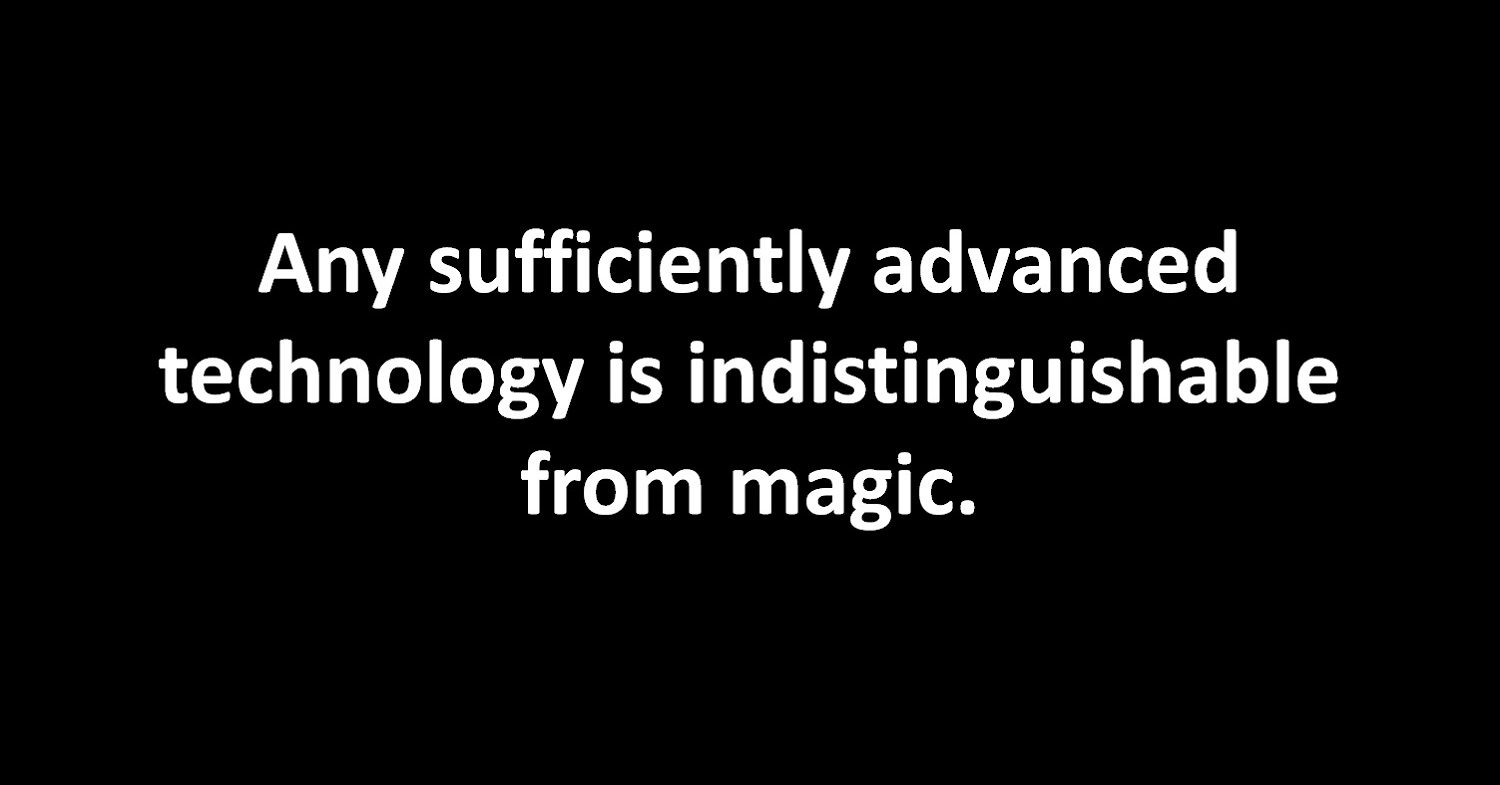The Long View: Third Law Conservatism

John Reilly proposes here an interesting psychology of schism:
The usual motive for schism, however, is conservative: new groups form because they believe that the old one has departed from tradition in some way.
For groups like the Old Catholics [split from the Catholic Church after Vatican I proposed papal infallibility] and the Old Believers [split from Russian Orthodoxy after a 17th century liturgical reform], this seems just so. One might argue the Great Schism of 1054 and the Protestant Reformation fall into this pattern as well, but that might stretch the point too far, and not entirely be fair to the latter events.
Third Law Conservatism
According to Wikipedia, the online encyclopedia that is rapidly approaching a state of badly edited omniscience, Clarke’s Third Law runs thus: “Any sufficiently advanced technology is indistinguishable from magic.” The Clarke here, of course, is Arthur C. Clarke, the venerable science-fiction writer who is credited with conceiving the communication satellite. His Third Law (the other two need not detain us) is among the most widely quoted aphorisms in the culture of cyberspace, and indeed among the enthusiasts for all new technology with an information component. It expresses the hope that matter can be wholly subjected to the imagination.
The Third Law is not without empirical support; certainly it reflects something of the experience of anyone who has lived a reasonably long life in an advanced country during the past two centuries. It also seems to be the case that the latter technological innovations are more uncanny than the former ones. Perhaps technological progress is inevitable and perpetual. More likely, it approaches an ultimate state where reality is a work of art. In any case, the point I want to make here is that the freedom afforded by technological power does not simply dissolve the world and human nature in mere caprice: quite the opposite, in fact.
Consider, for instance, Jonathan V. Last’s piece in First Things, God on the Internet. In that survey of religious expression in cyberspace, the author makes all the points that conservatives usually make about the cultural effects of the Internet. Religion online, Last notes, tends to become politicized, consumerist, and worst of all, denominationalist. Little groups of the saved create their webrings of the like-minded where neither authority nor informed criticism can enter. In this regard, cyberspace has lent its unique facility of disintermediation to the extension of what was already a deplorable tendency in modern religious life.
But there is this: these little cyberchapels are rarely liberal, much less daringly original. We find almost none of the new mutations of the spirit that many people (including me, frankly) were expecting only a few years ago to emerge from the ether of electronic environments.
Denominations form online for much the same reasons that they form in the outer world. Occasionally, someone pronounces a doctrinal innovation and convinces a fraction of an older religious body to break off and form a new group. The usual motive for schism, however, is conservative: new groups form because they believe that the old one has departed from tradition in some way. And in fact, conservatism in this sense has been typical of cyberspace in general. There are many reasons why conservative politics prospered in the United States through the latter 20th century, but part of the answer has to be just this pattern of refusal by newly empowered individuals to follow what they believe to be departures from historical norms of governance.
The Third Law has merit if by magic we mean the magic of fairytales. That kind of magic is normally conservative, or at least nostalgic. We see it deployed in the fantastically successful Lord of the Rings and Harry Potter film series. Purely surrealist fantasies have also been cinematicized, sometimes with commercial success, but none has had the impact of the works that present traditional themes and traditional images. To some extent, the reception of these was prepared by their familiarity as literature, but we must also consider that their force rests on the inherent power of their traditional elements: indeed, that those elements became traditional because they are powerful. The new power of illusion serves to visualize a world that never was, but that, somehow, always is.
Christian parents who worry that these series are propaganda for an occult view of the world should not be lightly dismissed. There is popular entertainment, particularly branches of popular music, which seeks to do just that. Magic in that sense, however, is magic in the sense that some anthropologists use it: magic as the illicit and private appropriation of a society’s religion. This is almost never a feature of digitalized sword-and-sorcery.
Whether on the screen or in print, this type of fantasy can be used to allegorize an orthodox religious message, as C.S. Lewis and Tolkein have demonstrated. (The Lord of the Rings is really about the relationship between grace and works, but that is another essay.) By no means do all such stories have a spiritual message, however, or even most of them. Was there ever a more secular institution than Harry Potter's Hogwarts? It is essentially a trade school. The Harry Potter stories might not work all that differently if the school had been founded to educate young prodigies with an aptitude for computer programming; instead of invoking supernatural powers, the students might as well use their dog Latin to operate voice-activated computer interfaces.
What all these stories have in common is an animate world, an ensouled world, that responds directly to the human mind. The world of animism is the most intuitive for human beings. Science itself assumes such a mind-friendly world even when it is dispelling crudely animist superstition. Given the premise of historical progress, whatever is intuitive is easy to see as inevitable. Clarke's Third Law implicitly posits a model of history in which the world evolves from material to animate.
This seems to be the real implication of Ray Kurzweil's The Singularity Is Near : When Humans Transcend Biology. The notion is pure Hegel, which is hardly a criticism. Kurzweil hangs his forecast from computer science, and suggests that a very radical disjuncture from history and biology will occur by the middle of the 21st century. We should note, however, that much the same model can rest on different premises (and indeed many lesser lights have made many of the points that Kurzweil has). Most notably, the historian Henry Adams proposed an analogous idea 100 years ago, in the essays “The Tendency of History,” “A Letter to American Teachers of History,” and “The Rule of Phase Applied to History.” The idea achieved bestseller exposure in the Adams autobiography, The Education of Henry Adams: specifically in Chapter 34, A Law of Acceleration.
Adams derived his progression from growing energy use as measured by the consumption of coal. Like Kurzweil, his acme point was projected for just a few decades in the future, which in Adams’s case meant the first half of the 20th century. The physical model he favored as an analogy to the evolution of mind in the modern era was a cometary hyperbola. The comet moves very slowly, except for its brief stay in the inner solar system. Then it accelerates with stunning swiftness until it makes its closest approach to the sun. After that, it is flung out into space, where it again moves slowly among the stars. Adams's model allowed for the possibility that Earth might literally explode when historical acceleration reached its peak, but he suggests that the human race will "change phase," like a solid turning to a liquid, or a liquid to a gas. Modernity is simply the era of transition. After modernity will follow a future that, like the premodern past, is essentially changeless.
We know a bit more about the cultural effects of technology than Adams did. As we have seen above, one of the things we know is that technology sometimes favors the archaic. It has become a cliché to note that technological progress promotes personal interaction and networks. Human beings are not herd animals, and are never entirely comfortable being part of a mass. The drift of technology is toward a future in which everyone can act like a pack animal again: the rifleman of the First World War is wholly obsolete, but the knight is back, in electronic body armor.
Important as this trend is, I would suggest that the most important conservative effects of technology are more subtle. It might be too much to say that every human being secretly wishes to live in Minas Tirith, or even in the Shire. However, it may well be the case that the heart’s desire does not volatilize in all directions when freed from the constraints of physics and economics. In the space of the imagination, there are islands of stability. Information technology allows us to explore them in fine detail, but that technology did not create them, or even discover them.
In The Anatomy of Criticism, Northrop Frye notes that the progression of history in the Bible is marked by a change in man’s relationship to the world. In the beginning, the human body is contained in the garden that is the world. At the end, the body contains the world. The body is the New Jerusalem, the symbol of the humanized universe. By no means do I wish to equate the world of fairy tales with the eschaton, even the world of very good fairy tales like Tolkien’s, or to suggest that technological progress is the engine of salvation. Nonetheless, the humanization of the world that Frye proposes is at least in part a tale of technology, and the result must be something very like the magic of Clarke’s Third Law.
The irony is obvious. Technological optimists these last few centuries have trumpeted the power of technology to supersede all historical institutions and to replace them with radically new forms of life and thought. However, when freed from constraint, the creative impulse does not necessarily pursue the radically new. Frye suggested the opposite, at least with regard to literature: the only way in which writers can really be original is by reaching back to the origins, to the small set of plots and character types that inform all fiction. Original works in this sense simply break through ephemeral artistic conventions to a fresh representation of primordial forms. Similarly, the magic of the Third Law has in recent years served more to revive and conserve old ideas than to generate genuinely new ones.
Conservatism in this sense is not necessarily a bad thing, but then neither is it necessarily a good one. No one in his right mind would want to be the subject of a fairy-tale kingdom, even one without dragons. There can be tension between Burkean conservatism and Third Law conservatism, between the conservatism of deference to sentiment and the conservatism that seeks to incarnate archetypes which history may illustrate but does not define. Perhaps the most radical of all 20th-century ideologies, Tradition, has yet to be fully heard from. Tradition in this sense comes in various forms, but at its worst, it looks directly to the archetypes and distains all actual history. As an element of fascism, it had limited scope to develop. In a world where reality is becoming a work of art, its projects may be more practical.
For myself, I do not believe that Third Law Conservatism tends to a dark tyranny. Quite the opposite: we are dealing here with another version of Hegelian optimism, which itself was only a timid restatement of Joachim of Fiore's millennialism. One takes all such notions with a grain of salt, but we are wrong to dismiss their optimism. Indeed, faith in the providential structure of history is not just comforting, it is the predicate of sanity. It must, therefore, figure somewhere into any usable conservatism.
Copyright © 2006 by John J. Reilly



Comments ()